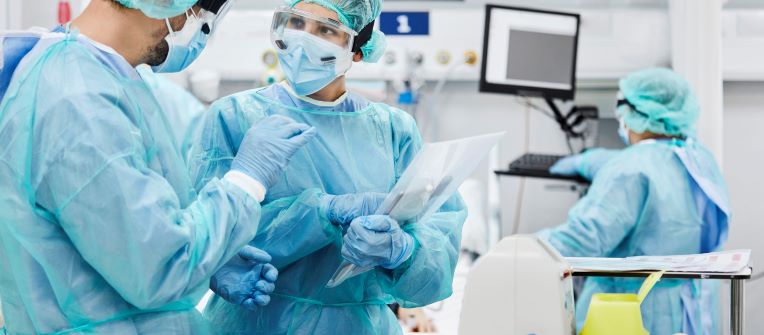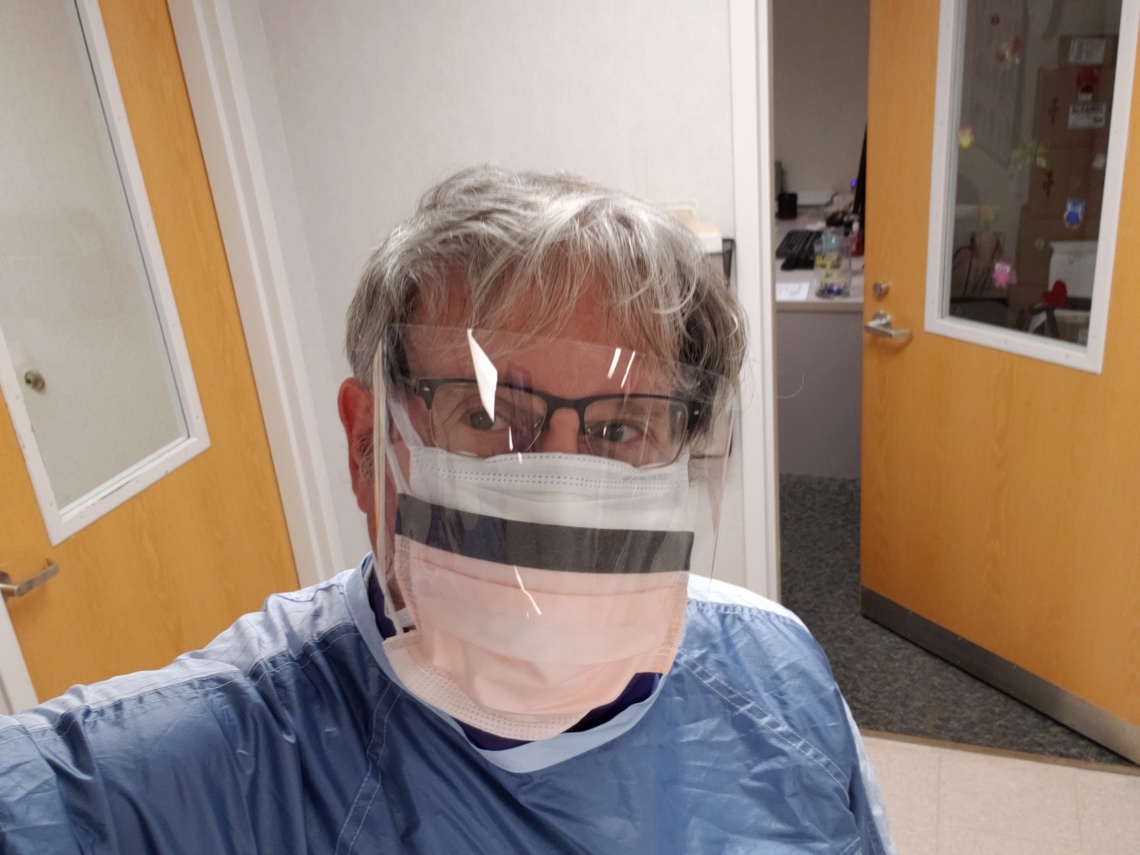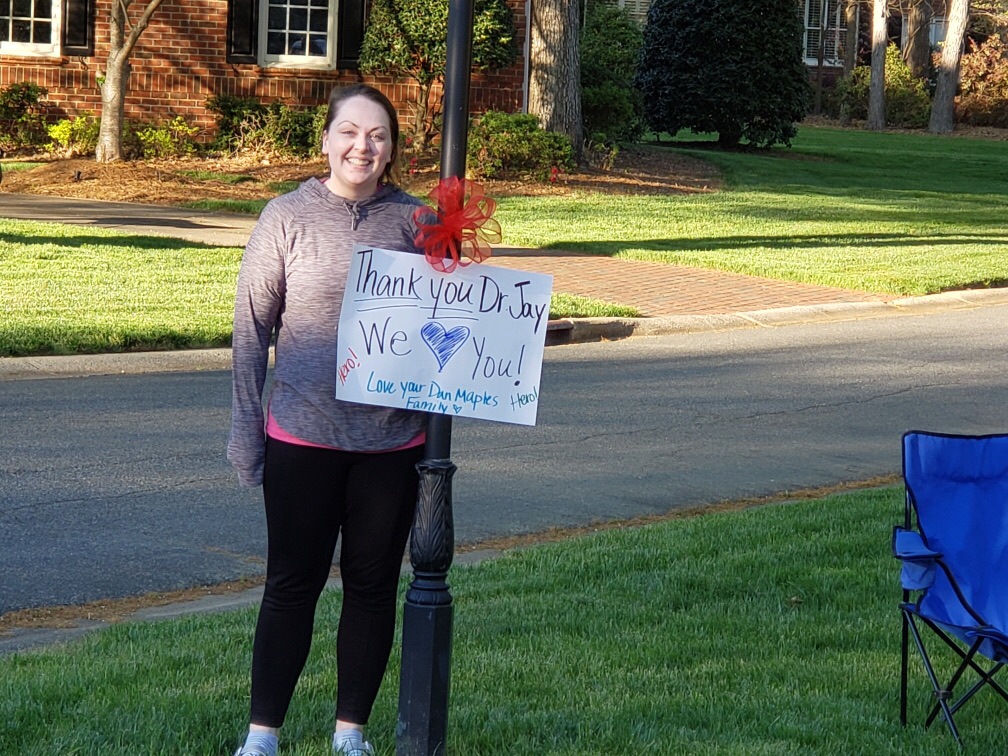
On the Front Lines with Dr. Jay Hendler
The novel coronavirus, COVID-19, is not something you want to get. That is what Dr. Jay Hendler, Medical Director of Pulmonary Medicine and Chief of Staff Elect for CaroMont Regional Medical Center, wants the public to know. Having made lung health and the treatment of lung disease his focus for decades, Dr. Hendler admits he has never seen anything like the COVID-19 pandemic.
“It’s called a novel virus because it’s new,” Dr. Hendler explains. “Over the last nine months, we have learned a lot, but there is still so much the medical community does not know. It’s important to take this virus seriously, not only because it can be deadly, but because patients are not guaranteed to fully recover and are potentially facing months or years of complications like ongoing fatigue, blood clots and serious heart issues. COVID-19 could have lasting negative effects on your health.”
Dr. Hendler is board certified in Internal Medicine, Critical Care and Pulmonology. His typical patient has lung issues or disease that affects breathing, like asthma, Chronic Obstructive Pulmonary Disorder (COPD), pulmonary hypertension (high blood pressure that affects arteries in the lungs and heart) and lung cancer. In a region where these issues are more prevalent, COVID-19 is all the more concerning because it can be especially dangerous for people with those issues.
“We know there are certain risk factors that contribute to more severe cases of COVID-19,” said Dr. Hendler. “Hypertension, diabetes and obesity appear to contribute to complications and people who have a weakened immune system are at greater risk. We are also seeing a correlation between advanced age and worse outcomes, but it’s not just people who are older or unwell. While the chances of being severely impacted increase as you get older or have multiple medical problems, healthy people in all age ranges can get devastatingly ill. It may not be as common, but it is certainly still a concern.”
Unfortunately, the medical community does not yet understand why some people get very sick and others have mild cases or no symptoms at all. But it is very clear that those who do not experience symptoms can still spread COVID-19, and that is one of many reasons this virus is more troubling than colds or flu which are mostly contagious once symptoms are present.
“One thing we have been able to learn quickly about this virus is how it spreads,” Dr. Hendler explains. “It is not transmitted through skin; it is transmitted in the air. When people cough, breathe or sneeze, they spread droplets into the air that can carry COVID-19. Those infected droplets float and can then be inhaled by another person. It happens invisibly, which is one reason the virus has spread so easily.”
In fact, COVID-19 cases surpassed 1,000,000 just 94 days after the first was reported to the World Health Organization (WHO). While it can feel like the guidance on how to protect one’s self changes frequently, Dr. Hendler recommends what medical professionals call “standard precautions.”

 Dr. Hendler treats patients on the COVID-19 units at CaroMont Regional Medical Center.
Dr. Hendler treats patients on the COVID-19 units at CaroMont Regional Medical Center.
Protecting Yourself and Others
“There are three mainstays to prevent transmission,” says Dr. Hendler. “First, physically distancing yourself at least six feet from people who are not in your inner circle. Second, washing your hands with plain old soap will kill the virus and keep you from inadvertently transmitting the virus from your skin into your eyes, nose or mouth.”
The third way, wearing a mask, is one Dr. Hendler stresses, especially considering an individual without any symptoms can spread the virus unknowingly. He explains that for masks to be effective, we must adopt an “all in” approach.
“It’s important to understand that the protection offered by a mask keeps you from spreading the virus to others,” said Dr. Hendler. “If everyone around you wears a mask, then they are blocking their own potentially infected droplets and in turn, protecting you. Wearing a mask must be understood as a common courtesy to those around you. It must be a collective effort.”
Looking Ahead
Dr. Hendler believes that if everyone took simple precautions consistently, the spread and impact of COVID-19 would be dramatically reduced. And while vaccine producers race to create a vaccine, Dr. Hendler is realistic about the time it could take to develop and distribute a safe and effective vaccine.
“While we have very successful examples of virus eradication and prevention, like polio and measles,” explains Dr. Hendler, “there are viruses with no vaccine. We still do not have a vaccine to prevent the common cold, and while there are very effective anti-viral options to treat HIV, we have been looking for a vaccine to prevent AIDS since its discovery.”
For a vaccine to work, it has to confer immunity without negative effects for the recipient. At this point, science has shown people do develop antibodies for COVID-19, but it is not fully understood if those antibodies create permanent or long-lasting immunity. Having a safe and effective vaccine available would be an incredible step forward, but producing and distributing any vaccine to billions of people will also take time. In other words, Dr. Hendler believes this public health crisis is far from over. After a 35-year career in medicine, he never imagined a pandemic of this scale.
“Every professional in our hospital community is trained to do one thing: help people,” he says. “We want to provide supportive care and when faced with a problem, we want to fix it. COVID-19 challenges us every day. While caring for our patients is what we committed our life’s work to, it can be frustrating and exhausting to not have a solution for this illness. Still, we come together, and we work for the health of our patients. It’s what we do.”
Adamantly, Dr. Hendler impresses that every healthcare employee is working through similar struggles, layers of personal protective equipment and the concern of becoming infected themselves. However, he is buoyed by the community he serves and relays a story about coming home after a long shift of treating patients at CaroMont Regional Medical Center.
“I drove into my neighborhood and there were ribbons and signs of support, and not just for me,” he says, “but for all the doctors and nurses and healthcare professionals everywhere. Being reminded that your work is meaningful and appreciated meant a great deal to me. I will never forget that during the most challenging time of my career, this community cheered us on.”

 A neighbor offers support for healthcare workers on the front lines of the pandemic.
A neighbor offers support for healthcare workers on the front lines of the pandemic.
